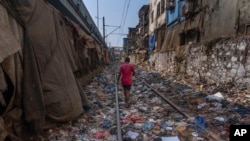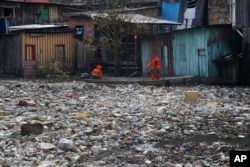The world creates about 52 million metric tons of plastic pollution every year, a new study says.
More than two-thirds of that plastic comes from the Global South – a term that loosely describes developing countries.
The amount of pollution is enough to fill New York City’s Central Park with plastic waste as high as the Empire State Building, researchers at the University of Leeds in Britain say.
They examined waste produced on the local level at more than 50,000 cities and towns across the world for a study recently released in the publication Nature.
The study examined plastic that goes into the open environment. It did not examine plastic that goes into landfills or is properly burned. For 15 percent of the world’s population, government fails to collect and dispose of waste, the study said.
This lack of collection and disposal is a big reason Southeast Asia and Sub-Saharan Africa produce the most plastic waste.
Lagos, Nigeria, released the most plastic pollution of any city, said Costas Velis, the study’s lead writer. The other biggest plastic-polluting cities are New Delhi in India, Luanda in Angola, Karachi in Pakistan, and Cairo, in Egypt.
India leads the world in producing plastic pollution, with more than 9.3 million metric tons a year. That number is far more than double the next big-polluting nations, Nigeria and Indonesia. China, often criticized for pollution, is in fourth place but is making big improvements in reducing waste, Velis said. Other top plastic polluters are Pakistan, Bangladesh, Russia and Brazil. The top eight nations are responsible for more than half of the world’s plastic pollution, the study’s data suggests.
The United States takes 90th place in plastic pollution with more than 47,600 metric tons. And Britain takes 135th place with nearly 4,600 metric tons, the study says.
In 2022, most of the world’s nations agreed to make the first legally binding treaty on plastic pollution, including in the oceans. Final treaty negotiations take place in South Korea in November.
The study used artificial intelligence to research plastics that were improperly burned — about 57 percent of the pollution — or just dumped. In both cases, very small microplastics, or nanoplastics, are what change the issue from a marine life problem to a human health threat, Velis said.
Several studies this year have looked at how common microplastics are in our drinking water and in people’s tissue, such as hearts, brains and testicles. Doctors and scientists are still not quite sure how microplastics threaten human health.
Velis called the spread of microplastics “everybody’s problem” and one that will be an issue for future generations.
“We shouldn’t put the blame, any blame, on the Global South,” Velis said. “And we shouldn’t praise ourselves about what we do in the Global North in any way.”
The problem is a lack of resources and ability of government to provide the necessary services to citizens, Velis said.
Outside experts worried that the study’s attention on pollution, rather than overall plastic production, means the plastic industry is not held responsible.
The United Nations Environment Program estimates that plastic production is likely to rise from about 400 million metric tons a year to more than 1.1 billion metric tons. And many scientists believe plastic production releases large amounts of greenhouse gas that contribute to climate change.
Neil Tangri is senior director of science and policy at GAIA, a group of international organizations working on waste and environmental programs.
Tangri said of the study’s researchers, “These guys have defined plastic pollution in a much narrower way, as really just macroplastics that are emitted into the environment after the consumer, and it risks us losing our focus on the upstream and saying, hey now all we need to do is manage the waste better.”
Tangri added, “It’s necessary but it’s not the whole story.”
I’m John Russell.
Seth Borenstein reported on this story for the Associated Press. John Russell adapted it for VOA Learning English.
____________________________________________
Words in This Story
landfill – n. a system of trash and garbage disposal in which the waste is buried between layers of earth
dispose of – v. to get rid of
bind -- v. to put under an obligation
dump – v. to get rid of something in a careless way
emit -- v. to give off or to throw out; to release
focus – n. a center of activity or attention
upstream – n. in or to a position within the production stream closer to manufacturing processes












Forum